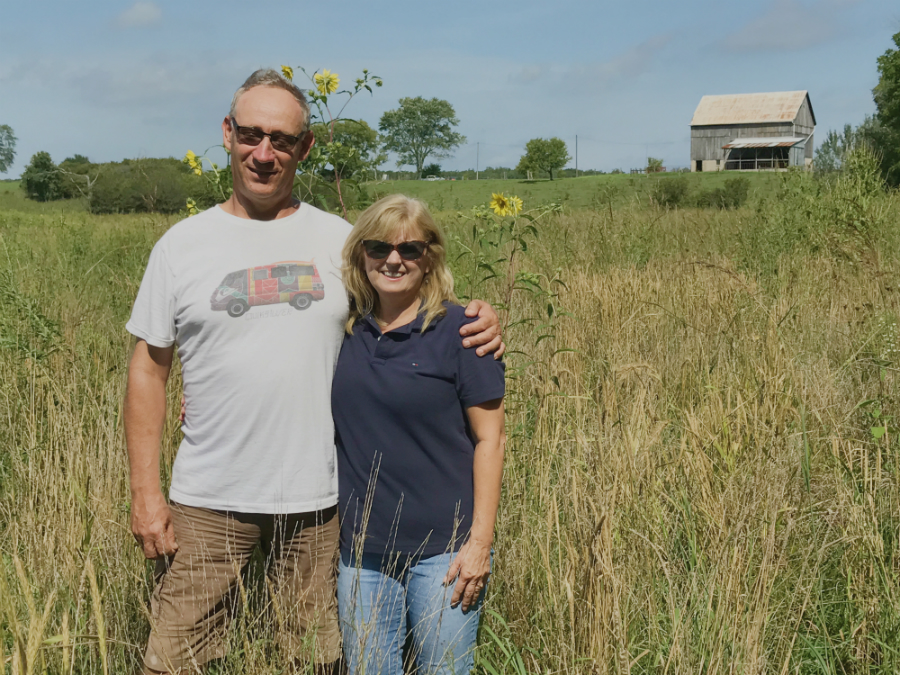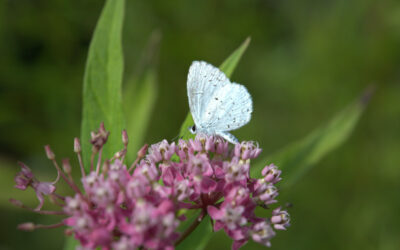ALUS Lambton participants Scott & Susan Stephens produce 25 acres of ecosystem services in Brigden, Ontario.

ALUS Lambton participants Scott and Susan Stephens maintain eight ALUS projects on environmentally sensitive parcels of land on Meadowlea Farms, including this Ontario native tallgrass prairie project producing excellent habitat for pollinators and wildlife.
There are a number of impressive century farms across southwestern Ontario. And some of them, such as Meadowlea Farms Inc.in Brigden (St. Clair Township), are hard at work producing ecosystem services, such as cleaner water, cleaner air and more biodiversity, in addition to their traditional crops.
Meadowlea Farms has been in ALUS Lambton participants Scott and Susan Stephens’ family for 120 years. The land consists of 800 acres of fields growing cash crops such as corn, soybean, wheat, a 100-acre woodlot, 10 acres of pasture, and a little more than 25 acres of ALUS projects.
“The land we used for one of our ALUS projects was always hard to farm,” recalls Scott. “It was constantly flooding, the harvests were hit or miss, and it was risky pulling wagons up that steep hill. So we thought, why not just return those 16 acres back to nature? And that’s just what we did, thanks to ALUS Lambton.”
Signing up as participants in 2016, the Stephens now have eight ALUS projects established on environmentally sensitive parcels of land, including riparian and flood plain areas.
They have enhanced and created some wetlands and restored the buffer strips around them. They have also planted trees and shrubs to create wooded upland habitats, and planted Ontario native tallgrass prairie species to increase the grassland habitat on their land.
“Some of our fields have telephone poles in them, which are hard to farm around. We turned that area into a strip of native tallgrass prairie, to act as a buffer zone between the field and the ditch. It filters the water running off the fields to capture phosphorus, and serves as a wildlife corridor with food for pollinators and great cover for ground-nesting birds,” says Susan.

By next year, this ALUS project will be a thick strip of native tallgrass prairie growing more than seven feet tall. It will act as a buffer zone between the field and the ditch, capturing phosphorus and filtering the water running off the fields, and will serve as a wildlife corridor with food for pollinators and great cover for ground-nesting birds.
“On some of our other ALUS projects, we have trees growing in there now, we see more wildlife, more butterflies, and we have nice opportunities for outdoor activities with our family–we’ve gone canoeing up there, and skating and snowmobiling in the winter,” Susan continues.
All the Stephens’ ALUS projects are helping the environment in many ways. Their tallgrass prairie projects protect soil health while creating beneficial pollinator habitat, for instance.
Meanwhile, their wetland and riparian projects help improve fish habitat, water quality and quantity in the adjacent Black Creek, a major tributary to the Sydenham River, which is home to numerous species-at-risk.
In this way, the ALUS projects also help reduce phosphorus loads in the Sydenham River watershed, to contribute to a healthier ecosystem in the Great Lakes region for future generations.
As ALUS participants, the Stephens’ have seen first-hand the positive impacts ALUS projects can have on the landscape—now, they have started telling others about it. “Our ALUS projects are generating some interest from the neighbors,” he says. “We are happy to answer any questions, especially knowing that’s exactly how ALUS spreads on the ground: it’s a good idea that gets passed along from farmer to farmer.”
“Scott and Susan have always had a passion for the outdoors and for wildlife,” says ALUS Lambton Program Coordinator Lindsay Buchanan, recalling how their property was selected by the Ministry of Natural Resources many years ago as a good site to release wild turkeys as part of efforts to reintroduce the native bird to this region.
What’s more, says Buchanan “I think the Stephens are a great example of the motto I have adopted: ‘If you are going to live here, than live like you are going to stay here!’ This is something I heard University of Trent Professor Dan Longboat say, at a Carolinian Canada conference some time ago. It really struck a chord with me, and I try to promote it through my work with ALUS and Ontario NativeScape.”

ALUS Lambton participants Scott and Susan Stephens produce 25 acres of ecosystem services (cleaner air, cleaner water and more biodiversity) in Brigden, Ontario.
View short video on ALUS Canada’s YouTube channel.



